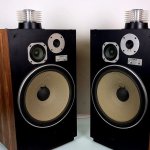It is similar to AMT, but not the same.
The folds are pressed together and the air between them is pushed out using a lever. An AMT does nothing different.
The folds are pressed together and the air between them is pushed out using a lever. An AMT does nothing different.
There is a "classic" voice coil below.How do you make accordion constrict like amt
There will be a difficulty to get the accordion flexible enough to allow "breathing" but still stiff enough to push air. But maybe it's just a question of geometry?
No, but I think this is close:
https://audioxpress.com/article/new-transducer-technology-from-christensen-audio
https://audioxpress.com/article/new-transducer-technology-from-christensen-audio
There's no pleating in MBL's radialstrahler, but the basic drive principle is the same.
https://www.mbl.de/en/loudspeakers
Every Radialstrahler chassis consists of individual petal-like segments, known as lamellae, which are arranged in a circle around a central axis, resulting in an elongated spherical shape. Each individual lamella is permanently fixed at its upper end and attached to a voice coil at the lower end, moving freely in and out of the magnetized gap.

https://www.mbl.de/en/loudspeakers
Every Radialstrahler chassis consists of individual petal-like segments, known as lamellae, which are arranged in a circle around a central axis, resulting in an elongated spherical shape. Each individual lamella is permanently fixed at its upper end and attached to a voice coil at the lower end, moving freely in and out of the magnetized gap.
Can you describe better that lever? I understand the voice coil is in the gap moving up and down, but where is the lever? How and where is it attached? In order to squeeze the harmonica on top, something must be fixed somewhere. Its not clear from your picture. Do a better drawing with the lever and full mechanism of action.It is similar to AMT, but not the same.
The folds are pressed together and the air between them is pushed out using a lever. An AMT does nothing different.
it won't, unless the folding membrane is very soft.It should work. In theory.
in order to compress and expand the diameters/circumferences of the inner and outer folding membrane edges would have to expand/compress very much.
in contrast to a simple 1-dimensionally folded AMT membrane this membrane has a double curvature, which means it is inherently stable and thus cannot be bent easily.
EDIT:
just compare it to paper cone membranes stacked on top of eachother.
cone membranes are very stable!
I suggest you build a model of paper and try it.
sorry - I quoted your post, but it's of course not related to your answer but to the thread opener's concept.Seriously?
I didn't want to offend you!
The design in the OP is going to require careful selection of the accordion material, with a tradeoff of mass, stiffness, elasticity, and manufacturability. But it looks like it could work, since it is not that different in principle from the MBL design. I think a better solution with fewer difficult tradeoffs is a cylindrical AMT driver. See this article for some implementation ideas.

The principle is indeed similar.it is not that different in principle from the MBL design.
But the diaphragm geometry is very different.
The mbl diaphragm has no double curvature thus it's flexible for the necessary "breathing".
You're right. 🙂it won't, unless the folding membrane is very soft.
in order to compress and expand the diameters/circumferences of the inner and outer folding membrane edges would have to expand/compress very much.
in contrast to a simple 1-dimensionally folded AMT membrane this membrane has a double curvature, which means it is inherently stable and thus cannot be bent easily.
EDIT:
just compare it to paper cone membranes stacked on top of eachother.
cone membranes are very stable!
I suggest you build a model of paper and try it.
I'll try a model made of very flat cones.
Hoping that the cones will bend. Then it would also have something of a DML😎
Not an "AMT" really as in an AMT the whole membrane is driven by a magnetic field (the "coil is in the macrame"). This is a pulsating mushroom on top of your ordinary voice coil. It will emit more close to the coil and less on the top juts because of losses in the material. It will have to be soft or it wont "accordion"... thats why it will not be very wideband... i.e. no real HF > 5k?
I doubt it will work any good and especially will have poor HF. But a fun idea - one would have thought we had seen most of them by now, but still surprises come along ;-D
Sorry for being a drag...
//
I doubt it will work any good and especially will have poor HF. But a fun idea - one would have thought we had seen most of them by now, but still surprises come along ;-D
Sorry for being a drag...
//
One more issue could be the sound radiated inside the harmonica circle. In ess amt, or any other amt, sound going back is beneficial in creating dipolar pattern. Here it would have to be perfectly eliminated.
- Home
- Loudspeakers
- Planars & Exotics
- Omnidirectional tweeter
